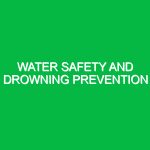In the vast expanse of waterways, the safety of personnel aboard boats during work operations is paramount. Boat safety for work operations refers to the protocols, regulations, and practices designed to ensure that individuals can perform their jobs effectively while minimizing the risk of accidents or injuries. In the Health, Safety, and Environment (HSE) domain, this focus on safety is not just a legal requirement; it is a moral imperative that underscores the responsibility of employers and employees alike. With many industries relying on watercraft—such as marine construction, fishing, and offshore oil drilling—insufficient attention to safety can result in catastrophic consequences. This article will delve into the intrinsic elements of boat safety for work operations, identify potential hazards, and outline best practices and regulations that govern this critical area.
The Importance of Boat Safety in Work Operations
Boat safety is fundamentally about protecting lives and ensuring operational efficiency. The work environment on a boat can be unpredictable, influenced by weather conditions, water currents, and the nature of the tasks being performed. A lack of safety measures not only endangers the crew but can also have significant financial implications for a business. For instance, the cost of a workplace accident can escalate quickly, involving medical expenses, legal fees, and damage to reputation.
Moreover, cultivating a culture of safety helps foster employee morale and productivity. When workers feel secure in their environment, they are more likely to focus on their tasks rather than on potential dangers. This sense of security ultimately contributes to a smoother operational flow, enabling organizations to achieve their objectives without interruptions caused by accidents.
Identifying Hazards Associated with Boat Operations
Understanding the hazards associated with boat safety is the first step in mitigating risks. Here are some of the most common hazards that can arise during work operations on boats:
1. Weather-Related Hazards
Weather conditions can change rapidly on the water. High winds, heavy rain, and fog can create dangerous conditions for navigation and operations. For example, I recall a fishing expedition off the coast of Oregon where a sudden storm forced the crew to abandon their catch and return to shore. The storm’s unpredictability highlighted the necessity of monitoring weather forecasts and having contingency plans.
2. Equipment Failures
Boats rely on various mechanical systems, from engines to navigation equipment. A failure in any of these systems can lead to serious accidents. Regular maintenance and inspections are essential to prevent equipment-related incidents. A story from a colleague in the marine construction industry illustrates this point: a crane malfunction on a barge resulted in a near miss when a load almost fell onto a crew member. Regular audits of equipment can help catch issues before they lead to accidents.
3. Human Factors
Human error is a leading cause of accidents in maritime operations. Distractions, fatigue, and inadequate training can result in poor decision-making. One anecdote from a rescue operation emphasizes this: a crew member was injured when another operator was distracted by a conversation. This incident underlines the importance of maintaining focus and ensuring all personnel are adequately trained and briefed before embarking on operations.
4. Slip and Fall Incidents
The deck of a boat can become slippery due to water, oil spills, or other substances. Falls can lead to serious injuries, and thus, it is crucial to implement measures to keep walking surfaces clean and dry. Installing non-slip mats in high-traffic areas can significantly reduce the risk of such incidents.
Safety Precautions and Best Practices
Once the hazards have been identified, implementing safety precautions is essential to ensure boat safety for work operations. Here are some best practices that can lead to safer working conditions:
1. Conduct Regular Safety Training
Training is a fundamental pillar of safety. All personnel should undergo regular training sessions that cover emergency procedures, equipment handling, and the specific risks associated with their roles. For example, a marine contractor may benefit from training that includes how to secure loads properly and respond to overboard incidents. This investment in education pays off when it prevents accidents and injuries.
2. Develop a Safety Management System (SMS)
An SMS outlines the safety policies and procedures that govern boat operations. It should include risk assessments, incident reporting mechanisms, and emergency response protocols. Engaging the crew in developing the SMS can ensure that it reflects real-world experiences and concerns, making it more effective. A successful example can be seen in the offshore oil industry, where companies have developed comprehensive SMS frameworks that significantly reduce incidents.
3. Regular Maintenance and Inspections
To mitigate the risk of equipment failure, regular maintenance checks should be scheduled. Documenting these inspections can also help in tracking equipment performance over time. A fishing company I once worked with saved thousands in repairs by implementing a rigorous maintenance schedule that identified minor issues before they escalated.
4. Use Personal Protective Equipment (PPE)
Ensuring that all workers wear appropriate PPE is non-negotiable. This includes life jackets, helmets, gloves, and slip-resistant boots. Each piece of equipment serves to protect workers from specific hazards related to their tasks. In a marine salvage operation, for example, life jackets are essential, especially when working near the water’s edge.
5. Establish a Clear Communication Protocol
Effective communication is crucial in boat operations. Establishing clear lines of communication can prevent misunderstandings that may lead to accidents. Regular safety briefings before work shifts can help ensure that everyone is on the same page. Additionally, using hand signals or radios can facilitate communication, especially in noisy environments.
Regulations and Standards Governing Boat Safety
Various regulations guide boat safety for work operations, ensuring that businesses comply with national and international standards. Some key regulations include:
1. United States Coast Guard (USCG) Regulations
The USCG sets forth regulations that govern the operation of commercial vessels, including safety equipment requirements and training standards. Compliance with these regulations is mandatory for businesses operating in U.S. waters.
2. International Maritime Organization (IMO) Standards
The IMO provides guidelines and conventions for maritime safety, including the International Convention for the Safety of Life at Sea (SOLAS). These guidelines are critical for ensuring vessels meet international safety standards.
3. Occupational Safety and Health Administration (OSHA) Guidelines
OSHA sets forth regulations that apply to workplace safety, including those specific to marine operations. Employers must create a safe environment for their workers, including adhering to OSHA standards related to falls, noise, and personal protective equipment.
Conclusion: The Path to Safer Work Operations on Boats
Boat safety for work operations is a multifaceted endeavor that requires vigilance, training, and a commitment to best practices. By identifying hazards, implementing safety precautions, and adhering to established regulations, companies can significantly reduce the risks associated with maritime operations. The stories and insights shared here reflect a collective understanding that safety is not merely a checklist; it is an ongoing commitment to protecting lives and enhancing operational efficiency. Prioritizing safety not only safeguards personnel but also strengthens the integrity and reputation of the organization. As we navigate the waters of work operations, let us remember: safety is everyone’s responsibility, and it begins with each individual on board.


